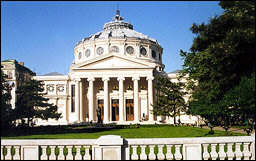 MUSIC MUSIC |
Romanians are very musical people. Music blasts out of any car or from any window in any Romanian city. During congregations, singing and dancing is almost mandatory. At the time of Communism Romanians tuned their taste for classical music. This was due to the educational system but also due to boredom, since there were no real commercial cinemas and TV just lasted a few hours playing dreadful propaganda programs. Today excellent concert, operas or ballet performances can be enjoyed throughout the whole Romanian territory.
 Classical Music Classical Music |
Romanian classical music remains virtually synonymous with Georghe Enescu, the musical gift of Romania to the World. His Romanian Rhapsodies first performed in 1903 still remain today his most popular works.
Most large cities have their own philharmonic orchestra or an opera house. As a heritage from Communist times, classical music does not have the elitist connotations than it enjoys in the West. Thus tickets are extremely cheap and musical events are open to all social classes and age groups.
In Bucharest, for instance, the Music University of Bucharest delivers mostly classical recitals usually free of charge.
The Bucharest Opera is always full house.
It stages mostly operas from Verdi, Puccini, Donizetti,
Bizet or Strauss. Even though the Opera does not
have as many means as other Central European capitals,
some performances can be of extraordinary beauty.
The Bucharest Opera House has their in-house singers,
but it often welcomes some of the most reputed Romanian
singers that are otherwise engaged in world tours
for most of the year. Curiously, at the end of well
known arias or beautifully performed ones the public
warmly applauds interrupting the normal flow of
events. It should be accepted as a normal practice
in this country. |
The Romanian Athenaeum an impressive Art-Deco building in the center of Bucharest hosts excellent concerts performed by the Romanian National and International Philharmonic Orchestras. Its circular interior is fully embellished with frescoes representing the History of Romania. The twisting marble staircases look like the inside of a conch shell.

 Folk music Folk music |
Transylvania is extraordinarily rich in music folklore. Its melodies are quite fast and rhythmic. Traditional ensembles are composed by a violin (contra) a double bass, and a cimbalom. Today these groups play at special occasions such as parties or weddings. At the turn of the XIX century Hungarian composer Bela Bartok found Transylvania a very fertile region for inspiration during his study trips on folk music. Probably the rich mix of nationalities had much to do with it.
In Wallachia village bands, generally named Taraf, are predominantly composed of Gypsies. The word Taraf comes from Arabic, suggesting a more oriental flavor of this music. These professional musicians play a vital function in village life.
Moldavian music played with an archaic pipe and drum sounds wild and out of this world. It is a mixture of music from Transylvania and the Balkans. |

